

Ulibre. Association for Learning Technology Special Interest Group on Moocs. Principles for Rhizomatic Thinking. This is the third in a series of posts which outline the thinking and planning Frances Bell and Jenny Mackness have been doing in preparation for their presentation – The Rhizome as a Metaphor for Teaching and Learning in a MOOC – for the ALTMOOCSIG conference on Friday 27th June.
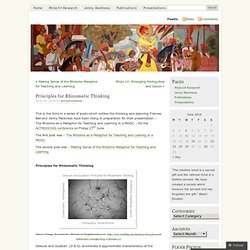
The first post was – The Rhizome as a Metaphor for Teaching and Leaning in a MOOC The second post was – Making Sense of the Rhizome Metaphor for Teaching and Learning Principles for Rhizomatic Thinking (Source of image: Deconstructive Rhizome by Pongtidasantayanon: Deleuze and Guattari (D & G) enumerate 6 approximate characteristics of the rhizome. So for now we’ll stick with the six principle characteristics, which are on the image above and listed below. In Week 2 of Rhizo14 a discussion arose in the Facebook Group around some participants’ perception that they were expected to study theory, and that some other participants’ posts were condescending. Big health warning here – these findings/thoughts are tentative. The Rhizome as a Metaphor for Learning in a MOOC. June 22, 2014 by jennymackness This is the first in a series of 4 blog posts which Frances Bell and Jenny Mackness have written in preparation for a presentation that we will give at the ALTMOOCSIG conference – MOOCs – Which Way Now?
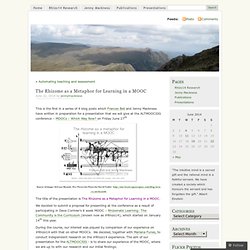
On Friday June 27th Source of image: Sylvano Bussoti. Making Sense of the Rhizome Metaphor for Teaching and Learning. This is the second post in a series of four about a presentation Frances Bell and Jenny Mackness will make at the ALTMOOCSIG on Friday 29th June this week.
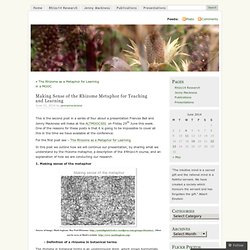
One of the reasons for these posts is that it is going to be impossible to cover all this in the time we have available at the conference. For the first post see – The Rhizome as a Metaphor for Learning In this post we outline how we will continue our presentation, by sharing what we understand by the rhizome metaphor, a description of the #Rhizo14 course, and an explanation of how we are conducting our research. 1.
Making sense of the metaphor Source of image: Mark Ingham. 6 Types of Blended Learning. Blended Learning is not so much an innovation as it is a natural by-product of the digital domain creeping into physical boundaries.
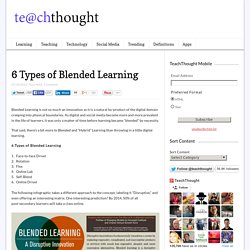
As digital and social media become more and more prevalent in the life of learners, it was only a matter of time before learning became “blended” by necessity. That said, there’s a bit more to Blended and “Hybrid” Learning than throwing in a little digital learning. 6 Types of Blended Learning Face-to-face DriverRotationFlexOnline LabSelf-BlendOnline Driver The following infographic takes a different approach to the concept, labeling it “Disruptive,” and even offering an interesting matrix. 8 Trends, 8 Opportunities, And 8 Concerns About Blended Learning. “8 Trends, 8 Opportunities, And 8 Concerns About Blended Learning” by Tom Vander Ark originally appeared on gettingsmart.com The directors of the International Association for K-12 Online Learning are an amazing group of system heads, school operators, philanthropists, and advocates.
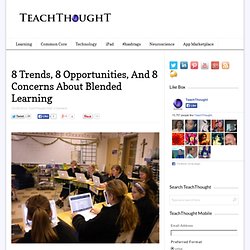
On Sunday we spent an hour discussing trends, opportunities and areas of concern for the rapidly world of online and blended learning. Following is a quick recap: Trends. 22 Things We Do As Educators That Will Embarrass Us In 25 Years. 22 Things We Do As Educators That Will Embarrass Us In 25 Years by Terry Heick Saw a picture today from the 1970s of a mother driving her car with her newborn baby in the passenger seat (no car seat).
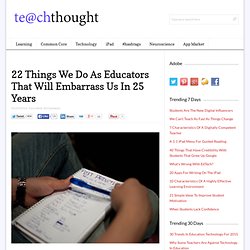
This, like pretty much everything else, got me thinking about education. What do we do now that in 25 years we’ll look back on and shake our heads? What are our “doctors smoking cigarettes while giving check ups” moments? 22 Things Education Does That Will Embarrass Us In 25 Years. The Learning Revolution Conference. We are pleased to announce the Learning Revolution Conference, online and free, April 21 - 25, 2014.

Our goal is to bring together people who are thinking about learning from our important learning places: the school, library, museum, work, adult, online, non-traditional, and home learning worlds. We want to explore and bridge the conversations about learning that are common to these worlds, including: learning theory, learning practice, learning science, learning space design, and technology for learning.
What are we "learning about learning? " The Internet is shifting the boundaries of these worlds and we believe that they will increasingly overlap and integrate. We also believe that conversations across these boundaries are critical to framing and preparing for the learning revolution starting to take place. The first three days of the event will have evening (US Time) keynote speakers. The conference will be held in multiple languages and time zones.
Web 2.0 Is the Future of Education. (Cross-posted from TechLearning) A moment of extreme clarity became an obsession for me last week.
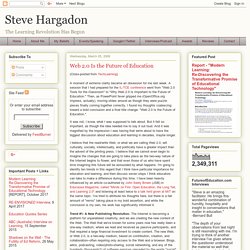
A session that I had prepared for the IL-TCE conference went from "Web 2.0 Tools for the Classroom" to "Why Web 2.0 Is Important to the Future of Education. " Then, as PowerPoint fever gripped me (OpenOffice.org Impress, actually), moving slides around as though they were puzzle pieces finally coming together correctly, I found my thoughts coalescing toward a bold conclusion and a final title change: "Web 2.0 Is the Future of Education.
" It was not, I know, what I was supposed to talk about. But it felt so important, as though the idea needed me to say it out loud. The Future of Education. Canadian Journal of Education/Revue canadienne de l'éducation. Search, Editor, English-language content of CJE: Deadline for submissions is 17 April 2014.
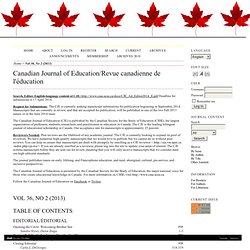
Request for Submissions: The CJE is currently seeking manuscript submissions for publication beginning in September, 2014. Manuscripts that are currently in review, and that are accepted for publication, will be published in one of the two Fall 2013 issues, or in the June 2014 issue. The Canadian Journal of Education (CJE) is published by the Canadian Society for the Study of Education (CSSE), the largest organization of professors, students, researchers, and practitioners in education in Canada. The CJE is the leading bilingual journal of educational scholarship in Canada.
Our acceptance rate for manuscripts is approximately 25 percent. Reviewers Needed: Peer reviews are the lifeblood of any academic journal. The journal publishes issues on early, lifelong, and Francophone education, and rural, aboriginal, cultural, pre-service, and inclusive perspectives. Dossiers. SCOOP! The Free Learning 2.0 Conference: Great Keynotes and Sessions and YOU! The Learning 2.0 virtual conference is just around the corner (August 20 - 24 We have an incredible lineup of keynote speakers and some GREAT practitioner sessions--AND there is still time for you to sign up to present (we hope you will do so)!

Learning 2.0 is a free conference and is held online, in multiple time zones, over the course of five days. It is a unique chance to participate in a global conversation on rethinking teaching and learning in the age of the Internet. It is organized in conjunction with Connected Educator Month, and the conference is based on a highly inclusive model for participation and designed to encourage peer professional development--which means we want you to come and learn from each other! The conference includes an all-day virtual unconference (SocialEdCon online!) As well as a special educational start-up "pitchfire" event. The conference is free to attend. E-learning et "web 2.0", un couple du XXIème siècle. “Internet n’est pas qu’une nouvelle façon de communiquer. Il instaure de nouveaux comportements, de nouvelles règles”, indiquait une équipe de chercheurs [1] voici quelques années.
Cette révolution a maintenant un nom : le “web 2.0”. Mais nommer n’est pas définir, d’autant que la définition change selon l’angle d’approche. Tantôt concept marketing, tantôt “fourre-tout” technologique, le web 2.0 est surtout le dénominateur commun des nouveaux usages d’internet, caractérisés par un degré élevé de personnalisation, le développement exponentiel de l’échange et la tendance à sa permanence. Today: A Conversation with Idit Harel Caperton on Constructionism, Social Learning, Web 2.0, Seymour Papert, and More. Join me today, Tuesday, March 12th, for a live and interactive FutureofEducation.com conversation with Idit Harel Caperton about her work and research on learning. Dr. Caperton is a pioneer in using new-media technology for creative learning, innovation, and globalization through constructionist learning theory. She founded the World Wide Workshop in 2004 to leverage her unique blend of award-winning research, business acumen, and leadership in spreading innovative new-media learning projects for benefiting kids and youth around the world.
Most recently, the Workshop launched Globaloria to invent ways of using social networking and Web 2.0 tools to teach computing and game-making in schools worldwide. Throughout the 1980s and 1990s, Dr. In 1995, she founded MaMaMedia and launched MaMaMedia.com, ConnectedFamily.com, and Papert.org. The Future of Education - Charting the Course of Teaching and Learning in a Networked World. Et si on enseignait vraiment le numérique ? Il faut relancer la Déclaration d'indépendance du cyberespace proclamée en... 1996 Le Monde | | Par Olivier Ertzscheid, maître de conférences à l'université de Nantes. Ils sont nés en 1996. Ils ont aujourd'hui 16 ans. L'ensemble de leur scolarité s'est faite dans l'ombre et la lumière du numérique. A leur naissance, le web est âgé d'à peine 7 ans. 16 ans plus tard, pour ces natifs du numérique, il ne reste plus rien de cette déclaration d'indépendance.
Apple, Facebook et Google décident seuls et en fonction de leurs seuls critères ce qui est publiable et ce qui ne l'est pas, invoquant le plus souvent le motif de "nudité" ou de "pornographie", et l'appliquant, par exemple, à la fermeture du compte d'un internbaute ayant osé choisir "l'origine du monde" de Courbet comme photo de profil. Vivre et apprendre avec les médias sociaux y compris et surtout à l’université. Danah Boyd lors Symposium pour l’enseignement et l’apprentissage avec la technologie le 18 avril dernier donnait une conférence Vivre et apprendre avec les médias sociaux ! Je trouvais son titre explicite et correspondant bien à la situation actuelle. J’affirme que les dangers d’internet et du web 2.0 sont déjà un débat récurrent et poussiéreux.
VidéosEducationnelles. Carrefour éducation. Exploration de la pédagogie du Web 2.0, Montérégie. PedagogieEtTic. A List of Great Checklists Every Teacher should Have. Checklists are tools that we the teachers and educators use probably on everyday basis.Obviously, they have several advantages as shown below and I personally love them. Educational Technology and Mobile Learning has been publishing some great checklists over the last couple of years. We have decided to go through all of them and come up with the list below. Some of the checklists are new and have been included here for the first time.